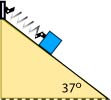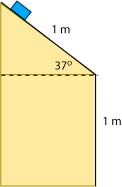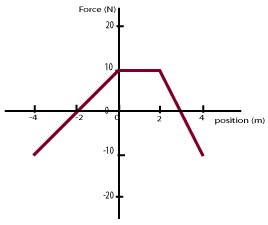Exercises on Work
Helena Dedic
Beware: Many of the solutions to these exercises use !
Exercise 1
A 60-kg skier slides down 200 m along a 25° slope. What is the work done by
(a) gravity; and
(b) by the force of friction which is 20 N?
Exercise 2
An x-component of a force acting on a particle varies with position as shown. Find the work done on the particle as it moves from
(a) x = -4 to -2 m
(b) x = -4 to 0 m
(c) x = 0 to 4 m
(d) x = -4 to 4 m
Exercise 3
A 1-kg mass is attached to a spring (k = 200 N/m) and allowed to fall. Let y = 0 at the point where the mass is attached to the spring before the fall.
(a) Calculate the work done by each force when the mass falls from y = 1 cm to y = 5 cm.
(b) Calculate the total work done on the mass under the same displacement.
(c) Starting from y = 0, determine how far the mass would have to fall so that the total work done would be zero.

Exercise 4
A 0.5-kg block is attached to a spring (k = 100 N/m) and slides 5.2 cm down an incline that is 37° to the horizontal. The coefficient of kinetic friction is 0.1.
(a) What work done is done on the block by gravity?
(b) What work done is done on the block by friction?
(c) What work done is done on the block by the spring?
(d) What is the total work done by the three forces?

Exercise 5
A 500 g particle moves in a circle of radius 0.5 m with constant angular velocity once every 2 seconds.
(a) What is the speed of the particle?
(b) What is the kinetic energy of the particle?
(c) What is the force acting on the particle?
(d) What is the work done on the particle in one revolution?
Exercise 6
Can work be done
(a) by the force of static friction, or
(b) by the net force acting on an object in a uniform circular motion (this force is often called a centripetal force)?
Exercise 7
A 1.5-kg block is moved at constant speed in a vertical plane from position 1 to position 3 via several routes shown in the figure. Find the work by gravity on the block for each segment indicated, where means work done from to :
(a)
(b)
(c)
Exercise 8
A 2-kg mass slides 1 m down an incline that is 37° to the horizontal, then falls 1 m to the floor.
(a) Calculate the amount of work done by gravity on the mass while it slides the incline.
(b) Calculate the amount of work done by gravity on the mass while it is in free fall.
(c) What is the total work done by gravity?

Exercise 9
If the net work done on a particle is zero, what can you conclude about the following:
(a) its acceleration
(b) its velocity










